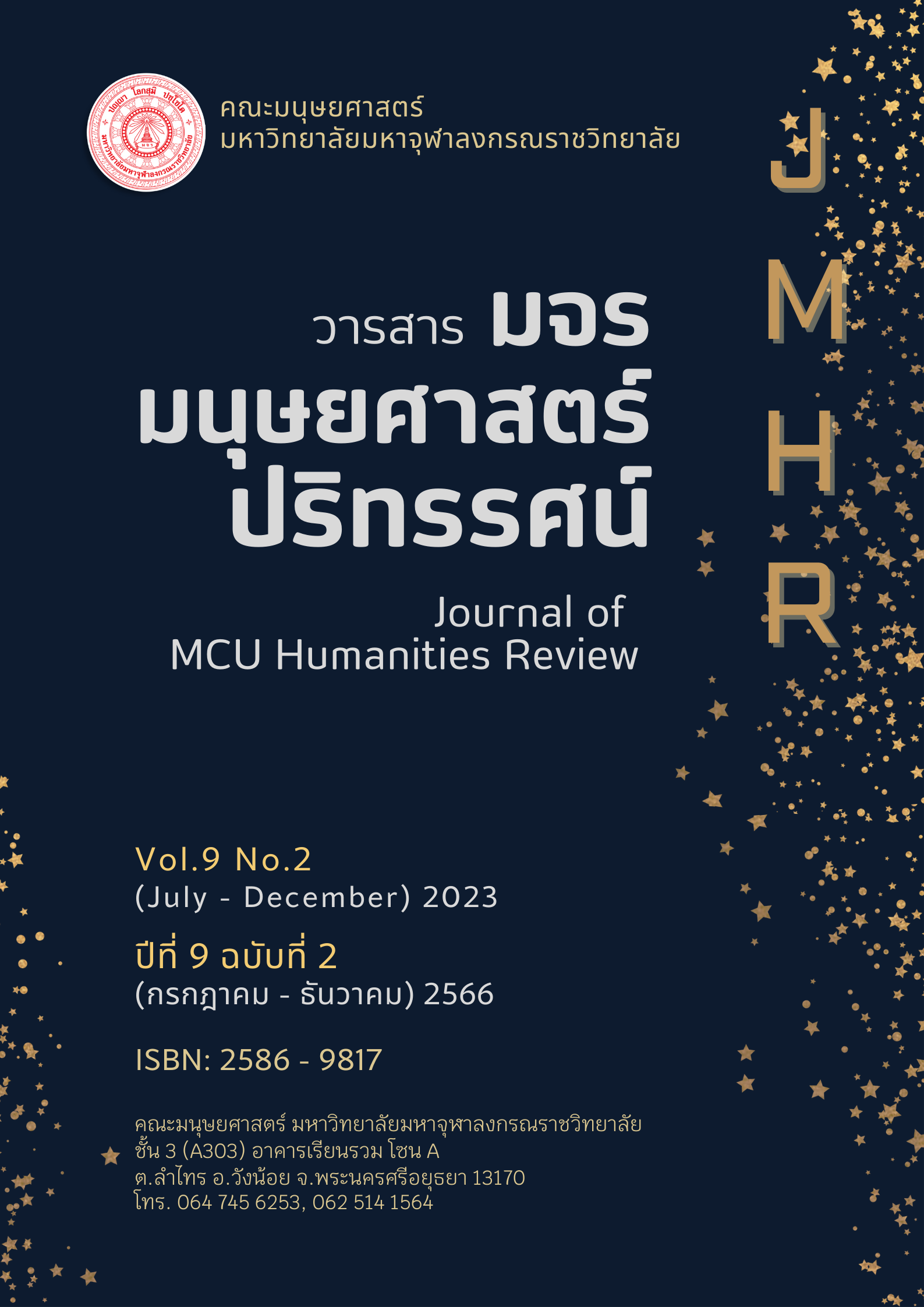ระบบการเผยแผ่พระพุทธศาสนาตามหลักปฏิสัมภิทา 4 สำหรับคณะสงฆ์จังหวัดเพชรบูรณ์
คำสำคัญ:
ระบบ, การเผยแผ่, ปฏิสัมภิทา 4, คณะสงฆ์, เพชรบูรณ์บทคัดย่อ
การวิจัยนี้มีวัตถุประสงค์ 1. ศึกษาองค์ความรู้ระบบการเผยแผ่พระพุทธ ศาสนาตามหลักปฏิสัมภิทา 4 สำหรับคณะสงฆ์จังหวัดเพชรบูรณ์ 2. ประเมินความต้องการระบบการเผยแผ่พระพุทธศาสนาตามหลักปฏิสัมภิทา 4 สำหรับคณะสงฆ์จังหวัดเพชรบูรณ์ 3. พัฒนากรอบแนวคิดการพัฒนาระบบการเผยแผ่พระพุทธศาสนาตามหลักปฏิสัมภิทา 4 สำหรับคณะสงฆ์จังหวัดเพชรบูรณ์ 4. พัฒนาระบบการเผยแผ่พระพุทธศาสนาตามหลักปฏิสัมภิทา 4 สำหรับคณะสงฆ์จังหวัดเพชรบูรณ์ และ 5. ทดสอบและประเมินหรือรับรองคุณภาพจากผู้ทรงคุณวุฒิ โดยได้สุ่มกลุ่มตัวอย่าง คือ คณะสงฆ์จังหวัดเพชรบูรณ์ ด้วยวิธีการเลือกแบบเจาะจง รวมทั้งหมด 9 รูป ใช้เครื่องมือเป็นแบบสัมภาษณ์ เพื่อการจัดการเรียนรู้ระบบ MOLQ System จากการวิเคราะห์เอกสาร เพื่อพัฒนาระบบตรวจสอบระบบ โดยการสังเคราะห์ข้อมูลและวิเคราะห์เนื้อหา
ผลการวิจัย :
- องค์ความรู้ระบบการเผยแผ่พระพุทธศาสนาตามหลักปฏิสัมภิทา 4 พบว่า นำหลักปฏิสัมภิทา 4 มาบูรณาการเป็นระบบและพัฒนาพระนักเผยแผ่ให้มีปัญญาแตกฉาน เรียกว่า ปรีชาแจ้งในอรรถ เข้าใจในธรรม ช่ำชองในภาษา คิดแก้ปัญหาทันการณ์
- ความต้องการระบบการเผยแผ่พระพุทธศาสนาตามหลักปฏิสัมภิทา 4 พบว่า คณะสงฆ์มี 2 ภารกิจ ได้แก่ 1) ภารกิจหลัก คือการสอนธรรมะ สวดมนต์ไหว้พระ นั่งสมาธิ ทำบุญตักบาตร 2) ภารกิจรอง คือให้การศึกษาแก่ราษฎรบนพื้นที่สูงและการพัฒนาคุณภาพชีวิตราษฎรจังหวัดเพชรบูรณ์
- พัฒนากรอบแนวคิดการพัฒนาระบบการเผยแผ่พระพุทธศาสนาตามหลักปฏิสัมภิทา 4 พบว่า ประกอบด้วย 1) ปรีชาแจ้งในอรรถ 2) เข้าใจในธรรม 3) ช่ำชองในภาษา 4) คิดแก้ปัญหาทันการณ์
- การพัฒนาระบบการเผยแผ่พระพุทธศาสนาตามหลักปฏิสัมภิทา 4 พบว่า สอดคล้องกับบทบาทพระสงฆ์ 6 ด้าน คือ 1) การปกครอง 2) การเผยแผ่ 3) การศาสนศึกษา 4) การศึกษาสงเคราะห์ 5) การสาธารณูปการ 6) การสาธารณสงเคราะห์ โดยพระสงฆ์ยุคโลกาภิวัตน์มีบทบาทสำคัญที่สุด คือ การอบรมสั่งสอนจริยธรรมแก่เยาวชนคนรุ่นใหม่ด้วยแนวทางการดำรงชีวิตถูกต้อง การอนุรักษ์ทรัพยากรธรรมชาติ สิ่งแวดล้อม ส่งเสริมวัฒนธรรมไทย เพื่อประโยชน์และความสุขแก่มหาชนเป็นสำคัญ
- ทดสอบและประเมินหรือรับรองคุณภาพจากผู้ทรงคุณวุฒิการพัฒนาระบบการเผยแผ่พระพุทธศาสนาตามหลักปฏิสัมภิทา 4 พบว่ามี 6 ด้าน คือ 1) ด้านการปกครอง: สอดส่องดูแลภิกษุสามเณรในปกครองให้ปฏิบัติตามพระธรรมวินัย 2) ด้านการเผยแผ่: ประกาศพระพุทธศาสนาให้พุทธศาสนิกชนทุกเพศวัยรับทราบทุกวิธี เน้นให้ความรู้เข้าใจหลักพุทธธรรมแล้วนำไปปฏิบัติในวิถีชีวิตประจำวัน 3) ด้านศาสนศึกษา: การศึกษาพระปริยัติธรรม แผนกธรรม-บาลี แผนกสามัญศึกษาและวิปัสสนาธุระ 4) ด้านการศึกษาสงเคราะห์: การอบรมปลูกฝังคุณธรรมจริยธรรม พุทธธรรมและการศึกษาขั้นพื้นฐานแก่เด็กและเยาวชน 5) ด้านสาธารณูปการ: การพัฒนาวัด อาคารสถานที่ให้เหมาะสมเป็นสัปปายะ 6) ด้านสาธารณสงเคราะห์: การช่วยเหลือสังคมทางวัตถุที่ไม่ขัดพระธรรมวินัย เพื่อประโยชน์และความสุขของมหาชน
References
พระครูใบฎีกาอภิชาติ ธมฺมสุทฺโธ (พรสุทธิชัยพงศ์). (2559). แนวโน้มการบริหารกิจการคณะสงฆ์ในทศวรรษหน้า (ดุษฎีนิพนธ์พุทธศาสตรดุษฎีบัณฑิต). มหาวิทยาลัยมหาจุฬาลงกรณราชวิทยา. พระนครศรีอยุธยา.
พระครูอุทัยกิจจารักษ์ (สุรางค์ สุจิณฺโณ). (2557). รูปแบบการบริหารจัดการการเผยแผ่พระพุทธศาสนาขององค์กรปกครองคณะสงฆ์ ภาค 2 (ดุษฎีนิพนธ์พุทธศาสตรดุษฎีบัณฑิต) มหาวิทยาลัยมหาจุฬาลงกรณราชวิทยาลัย. พระนครศรีอยุธยา.
พระธรรมกิตติวงศ์ (ทองดี สุรเตโช). (2551). พจนานุกรมเพื่อการศึกษาพุทธศาสตร์ คำวัด (พิมพ์ครั้งที่ 3). กรุงเทพฯ: ธรรมสภาและสถาบันบันลือธรรม.
พระธรรมปิฎก (ป.อ. ปยุตฺโต). (2543). พจนานุกรมพุทธศาสตร์ฉบับประมวลธรรม (พิมพ์ครั้งที่ 9). กรุงเทพฯ: โรงพิมพ์มหาจุฬาลงกรณราชวิทยาลัย.
“_________”. (2546). รุ่งอรุณของการศึกษา เบิกฟ้าแห่งการพัฒนาที่ยั่งยืน (พิมพ์ครั้งที่ 3). กรุงเทพฯ: มูลนิธิพุทธธรรม.
มหาวิทยาลัยมหาจุฬาลงกรณราชวิทยาลัย. (2539). พระไตรปิฎกฉบับมหาจุฬาลงกรณราชวิทยาลัย เล่มที่ 10 20 21 31. พระนครศรีอยุธยา : มหาวิทยาลัยมหาจุฬาลงกรณราชวิทยาลัย.
สิริวัฒน์ คำวันสา. (2534). ประวัติพระพุทธศาสนาในประเทศไทย. กรุงเทพฯ : โรงพิมพ์มหาจุฬาลงกรณราชวิทยาลัย.
Downloads
เผยแพร่แล้ว
How to Cite
ฉบับ
บท
หมวดหมู่
License
Copyright (c) 2023 วารสาร มจร มนุษยศาสตร์ปริทรรศน์

This work is licensed under a Creative Commons Attribution-NonCommercial-NoDerivatives 4.0 International License.





